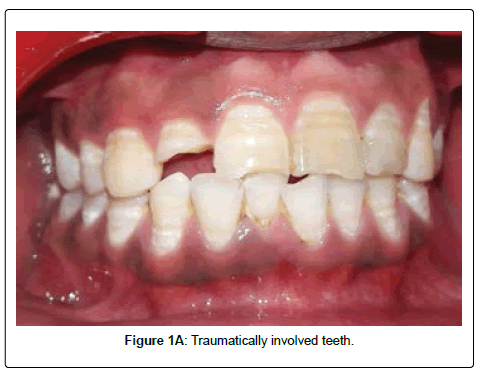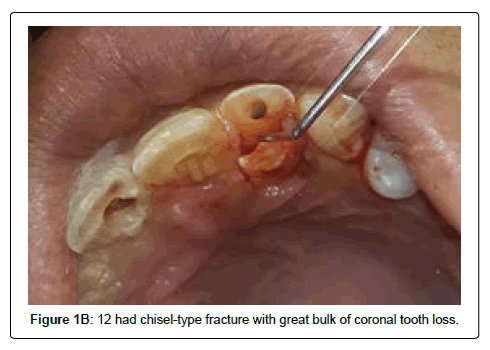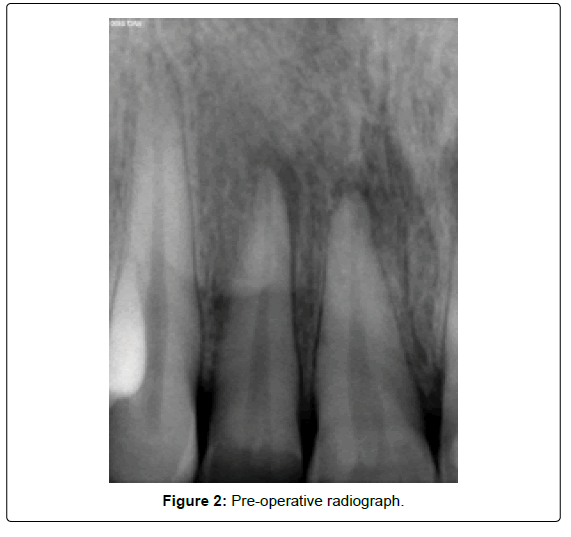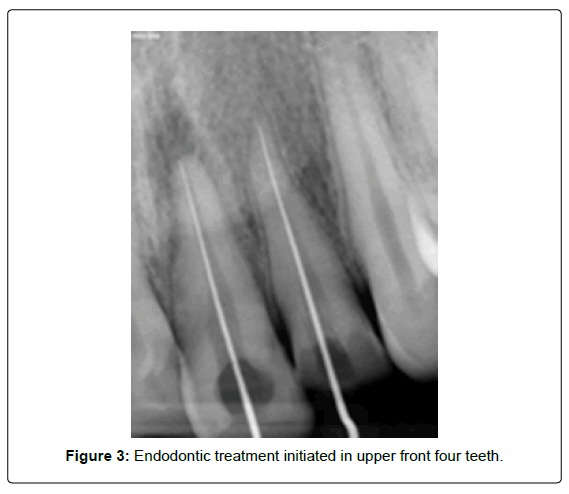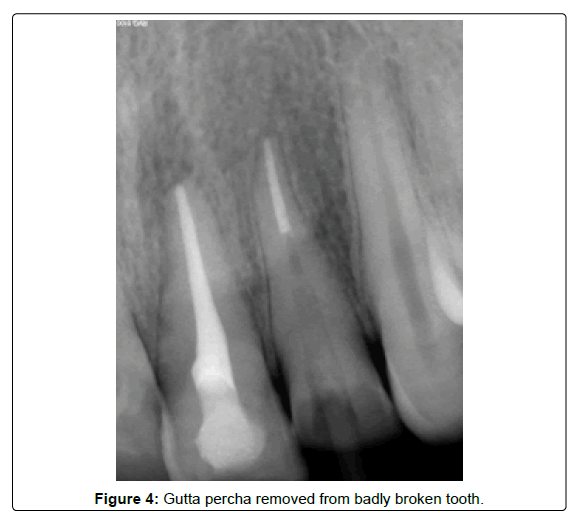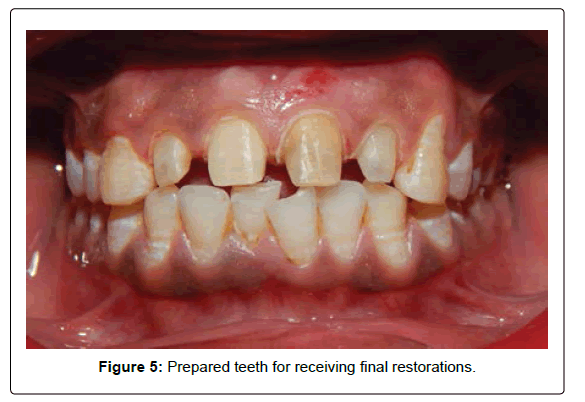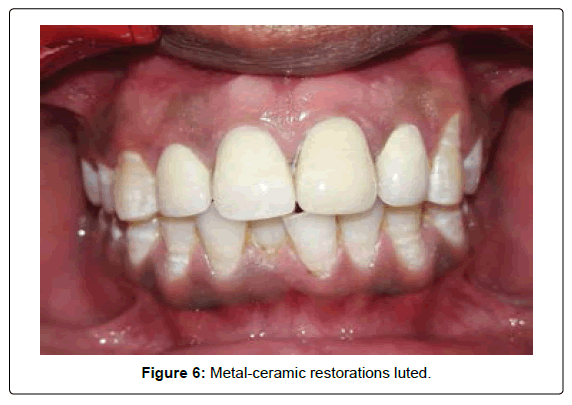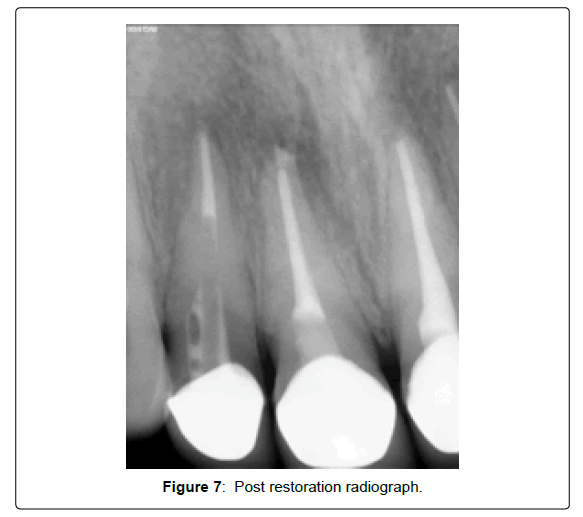Case Report Open Access
A Case Report on Restoration of Traumatically Involved Teeth with Fiber Post and Esthetic Restoration
Bishal Babu Basnet1* and Sanjay Ranjeet21Department of Prosthodontics, B. P. Koirala Institute of Health Sciences, Dharan, Nepal
2Center for Dental Education and Research, All Indian Institute of Medical Sciences, New Delhi, India
- *Corresponding Author:
- Bishal Babu Basnet
Department of Prosthodontics
B. P. Koirala Institute of Health Sciences
Dharan, Nepal
Tel: +977-9804307060
E-mail: bidrum43@gmail.com
Received Date: November 30, 2017; Accepted Date: June 13, 2017; Published Date: June 17, 2017
Citation: Basnet BB, Ranjeet S (2017) A Case Report on Restoration of Traumatically Involved Teeth with Fiber Post and Esthetic Restoration. J Oral Hyg Health 5: 223. doi: 10.4172/2332-0702.1000223
Copyright: © 2017 Basnet BB, et al. This is an open-access article distributed under the terms of the Creative Commons Attribution License, which permits unrestricted use, distribution, and reproduction in any medium, provided the original author and source are credited.
Visit for more related articles at Journal of Oral Hygiene & Health
Abstract
Background: The restoration of traumatically injured teeth with substantial loss of coronal structure entails endodontic treatment followed by post insertion into canal space so that foundation restoration can be strengthened to receive the crown. In this case report, such case is described with fiber-reinforced post and core system. Case details: A 30-year-old lady with chisel-type fracture of upper front teeth was treated with endodontic treatment followed by fiber-reinforced post and metal-ceramic restoration. Conclusion: The fiber reinforced restoration gives esthetically pleasing and biologically superior outcome in traumatically involved teeth.
Keywords
Fiber-reinforced post; Traumatized teeth; Post-and-core restoration
Introduction
When there is maximum destruction of coronal tooth structure a dowel and core restoration is required as foundation restoration of a crown [1]. The endodontic procedures tend to reduce tooth stiffness by 5-45% and mesio-occluso-distal preparation decreases the stiffness by 60% [2]. Water loss and loss of collagen cross-linking are the factors associated with brittleness of dentin of endodontically treated teeth [3-5].
A restoration lacking resistance form is not likely to be a long-term success, regardless of the retentiveness of the post [6,7]. Fiber posts have revolutionized the field of restoration of endodontically treated teeth. Technological advancement gave an ample opportunity to offer better esthetic and mechanical properties along with radiographically detectable quality in order to balance the advantages possessed by metallic cast posts [8-10]. Although fiber system was introduced in 1990, a long-term study was begun in 1988 when Friedriksson et al. [10] studied 236 teeth restored with posts.
Case Presentation
A 30-year-old lady who had an accident fracturing her multiple teeth reported to the hospital for her treatment. On examination, upper anterior teeth had chisel-type fracture (Figures 1A, 1B and 2). Some of teeth had large destruction owing to accident and coronal tooth structure was inadequate for restoration.
First, the endodontic treatment was carried out in all of her traumatized teeth [11-14] then the radiographs were taken (Figures 3 and 4). The tooth with greatest loss of coronal tooth structure [12] was judged to be a candidate for post-and-core restoration.
By using peeso reamers, gutta percha was removed and fiberreinforced composite was placed. Then the foundation restoration was completed with composite resin.
Usual tooth preparation was carried out to fabricate metal-ceramic crowns in all the endodontically treated teeth (Figures 5-7).
Discussion
The result of various studies have confirmed the longevity of fiber post [10,15]. Flexural properties of fiber posts render them responsible for prevention of root fracture [16]. Similarly, there have been reports of increased fracture resistance with preformed fiber posts as compared to control group [17]. However, systematic review comparing the metal posts and fiber posts had outlined greater survival rate (90%) in contrast to fiber-reinforced posts (83.9%) with overall equal incidence of fracture of root [18]. In a 3-year follow-up, superior result in terms of clinical success was observed in teeth restored with fiber post [19]. In another study fiber-reinforced composite showed highest mean fracture resistance in comparison to nano-hybrid and silorane [20].
Anatomic post, individualized according to canal space anatomy, offers a great advantage in relation to retention without compromising other advantages of fiber-post [21].
Stress pattern inside the canal was studied in endodontically treated teeth using finite element analysis which yielded that maximum stress was in stainless steel followed by cast gold and carbon fiber post [22]. Similar study also revealed that less amount of dentinal stress in fiberreinforced composite core as compared to other system [13]. However, role of incorporation of ferrule could not be overlooked to minimize the stress [13,14]. Therefore, only increase in diameter should not be the concern of restoration because it decreases the fracture resistance of root in gaining its ability to be stiff [23,24]. Fresno recommended thinnest possible diameter of dowel with adequate strength to resist fracture [25].
Conclusion
With use of fiber-reinforced composite post, the treatment of traumatically involved and endodontically weakened teeth can be easier and also more beneficial than other system. However, incorporation of various advantageous properties of post (ferrule effect, diameter, length, luting cement etc.) is of paramount importance for long-term success of such restorations.
Acknowledgement
The authors would like to acknowledge the patient for giving consent for the presentation of case. Also, the staffs and faculty members of Department of Conservative Dentistry, AIIMS are highly acknowledged for assisting in doing treatment of this case.
Conflict of Interest
The authors have no conflict of interest.
References
- Gutmann JL (1992)The dentin-root complex: Anatomic and biologic considerations in restoring endodontically treated teeth. J Prosthet Dent 67:458-467.
- Reeh ES, Messer HH, Douglas WH (1989) Reduction in tooth stiffness as a result of endodontic and restorative procedures. J Endod 15: 512-516.
- Helfer AR, Melnick S, Schilder H (1972) Determination of the moisture content of vital and pulpless teeth. Oral Surg Oral Med Oral Pathol 34: 661-670.
- Rivera EM, Yamuchi M (1993) Site comparison of dentin collagen cross-links from extracted human teeth. Arch Oral Biol38:541-546.
- Carter JM, Sorensen SE, Johnson RR, Teitelbaum RR, Levine MS (1983) Punch shear testing of extracted vital and endodontically treated teeth. J Biomech16: 841-848.
- Isidor F, Brondum K, Ravnholt G (1999)The influence of post length and crown ferrule length on the resistance to cyclic loading to bovine teeth with prefabricated titanium post. Int J Prosthodont 12:78-82.
- Lambjerg-Hansen H, Asmussen E (1997) Mechanical properties of endodontic posts. J Oral Rehabil 24:882-887.
- Asmussen E, Peutzfeldt A, Heitmann T (1999) Stiffness, elastic limit and strength of newer types of endodontic posts. J Dent 27:275-278.
- Drummond JL, Topke RS, King TJ (1999) Thermal and cyclic loading of endodontic posts. Eur J Oral Sci107:220-224.
- Friedriksson M, Astback J, Pamenius M, Avidson K (1998) A retrospective study on 236 patients with teeth restored by carbon-fiber reinforced epoxy resin posts. J Prosthet Dent 80:151-157.
- Malferrari S, Baldissara P, Arcidacono A (2002)Translucent quartz fiber posts: A 20-months in vivo study. J Dent Res 81:A-333.
- Ferrari M, Vichi A, Grandini S, Goracci C (2001) Efficacy of a self-curing adhesive resin cement system on luting glass-fiber posts into root canals: An ESM investigation. Int J Prosthod 14:543-549.
- Upadhyaya V, Bhargava A, Prakash H, Chittaranjan B, Kumar V (2016)A finite element study of teeth restored with post and core: Effect of design, material and ferrule. Dent Res J 13:233-238.
- Dejork B, Miotkowshi A (2013)The influence of ferrule effect and length of casts and FRC posts on the stresses in anterior teeth. Dent Mater 29:e227-e237.
- Malferrari S, Monaco C, Scotti R (2003) Clinical evaluation of teeth restored with quartz fiber-reinforced epoxy resin posts. Int J Prosthod16:39-44.
- Raju SR, Kilaru KR, Haridas KK, Naik B, Shetty K, et al. (2014) Evaluation of the flexural strength of carbon-quartz and glass fiber based posts. Saudi Endod J 4:109-114.
- Sharma S, Attokaran G, Singh KS, Jerry JJ, Ahmed N, et al. (2016) Comparative evaluation of fracture resistance of glass fiber reinforced, carbon and quartz post in endodontically treated teeth: An in-vivo study. J IntSocPrev Community Dent 6:373-376.
- Fiqueiredo FED, Martins-Filho PRS, Faria-e-Silva AL (2015) Do metal post retained restorations result in more root fractures than fiber post-retained restoration? A systematic review and meta-analysis. J Endod 41: 309-316.
- Amral M, Coppo PP, Rosalem CGC, Sauid FF, Guera SMG (2015)A 3-year retrospective evaluation of the clinical performance of fiber posts. Braz Dent J 26:619-623.
- Bilgi PS, Shah NC, Patel PP, Vaid DS (2016) Comparison of fracture resistance of endodontically treated teeth restored with nanohybrid, silorane and fiber-reinforced composite: An in-vitro study. J Conserv Dent 19:364-367.
- Grandini S, Sapio S, Simonetti M (2003) Use of anatomic post and core for reconstructing an endodontically treated tooth: A case report. J Adhes Dent 5:243-247.
- Kaur A, Meena N, Shubhashini N, Kumari A, Shetty A (2010) A comparative study of intra-canal stress pattern in endodontically treated teeth with average sized canal diameter and reinforced wide canals with 3 different post system using finite element analysis. J ConservDent 13:28-33.
- Trabert KC, Caput AA, Abou-Rass M (1978) Tooth fracture- a comparisonof endodontic and restorative treatments. J Endod 4:341-345.
- Trope M, Maltz DO, Tronstod L (1985) Resistance to fracture of restored endodontically treated teeth. Endod Dent Traumatol 1: 108-111.
- Fresno JP (1988) Guidelines for using posts in the restoration of endodontically treated teeth. Gen Dent 46:474-479.
Relevant Topics
- Advanced Bleeding Gums
- Advanced Receeding Gums
- Bleeding Gums
- Children’s Oral Health
- Coronal Fracture
- Dental Anestheia and Sedation
- Dental Plaque
- Dental Radiology
- Dentistry and Diabetes
- Fluoride Treatments
- Gum Cancer
- Gum Infection
- Occlusal Splint
- Oral and Maxillofacial Pathology
- Oral Hygiene
- Oral Hygiene Blogs
- Oral Hygiene Case Reports
- Oral Hygiene Practice
- Oral Leukoplakia
- Oral Microbiome
- Oral Rehydration
- Oral Surgery Special Issue
- Orthodontistry
- Periodontal Disease Management
- Periodontistry
- Root Canal Treatment
- Tele-Dentistry
Recommended Journals
Article Tools
Article Usage
- Total views: 7671
- [From(publication date):
September-2017 - Jul 03, 2025] - Breakdown by view type
- HTML page views : 6111
- PDF downloads : 1560

